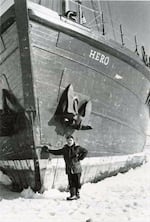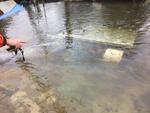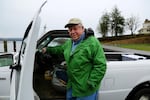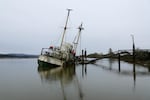
Hero Captain Pieter Lenie poses with the boat in particularly icy conditions in December 1977.
Miguel L. Brand-Wiener, Antarctic Journal. Courtesy of PalmerStation.com
Driving up the coast toward Bay Center, Washington, it’s obvious when you start to approach Willapa Bay. Fifteen foot high piles of shucked empty oyster shells began to appear on the side of the road. This is an oyster town.
But it's also home to a sinking piece of history.
Scott McDougall, the director of the Pacific County Emergency Management Agency, points out what remains of the Hero, an Antarctic research vessel from the 1960s.
In its prime, the Hero sailed through frigid temperatures and ice-strewn waters in the South Pole. According to a 1968 article in the Antarctic Journal, the ship was named after the sloop of 20-year-old Nathaniel Palmer, a seal hunter who became the first person to sight Antarctica. Throughout the late 1960s and 70s, the boat carried scientists to and from Palmer Station, a research center on Antartica's Anvers Island. The National Science Foundation eventually retired the floating laboratory in 1984.
Trouble In The Bay
“This is a vessel with an amazing amount of history,” McDougall says. “Just on a personal note, it makes me really sad to see what was once a beautiful vessel that was dedicated to promoting good ecology and good stewardship of the environment, to see it resting on the bottom and dying the death that it’s dying.”
McDougall was the first person to file a report on the sinking ship. While walking across the street to the Palix River, he points out one of many inlets and waterways that feed into the bay.
3-6-2017: Bay Center, WAShip sinking/sank off the Dike Rd.
Posted by Willapa Harbor Drone on Monday, March 6, 2017
“That’s one of the beauties of Willapa Bay,” McDougall explains. “There’s all sorts of streams and tributaries that feed into it, and there’s a good strong tidal inflow and outflow.
“This is one of the most pristine bays on the West Coast. And we have a lot of pride in that."
That sense of pride has been jolted by an oil sheen floating on the water’s surface below. The Hero’s faded green wooden bow, now covered in rust, peeks out of the water. By high tide, most of it will be underwater.

An oil sheen is visible on the surface of the Palix River near Willapa Bay. The oil has been attributed to the shipwreck of the former Antarctic research vessel Hero.
Washington Department of Ecology
Global Diving and Salvage, a Seattle-based company contracted by the state of Washington, has been helping with daily cleanup. Workers are using booms in the water and absorbent pads to soak up the materials. So far, they’ve removed about 1000 gallons of oily water and more than 60 gallons of diesel fuel and petroleum.
“We’re taking water samples and pictures every day and we’re changing out the absorbents as we see fit,” says Shawn Zaniewski, a spill responder with the Washington state Department of Ecology.
“This is a very old vessel. There could be small containers of oil on board. As the tide goes up and down, it’s going to continue to sheen like that until that stuff washes out.”

Cleanup crews working on the Hero shipwreck have removed 1,000 gallons of oily water and more than 60 gallons of diesel fuel and petroleum.
Molly Solomon / OPB
“When you have a vessel this old and made of wood, all of the surfaces of the area are impregnated with oil,” adds McDougall. “So, as long as the vessel is in the water, there’s going to be a sheen that comes off of it.”
That’s a huge concern for people who live and work here. Willapa Bay is where more than half of the state’s oysters are grown.
“It has an adverse effect on the bay, it has an adverse effect potentially on their pocketbooks,” McDougall says of the ship. “It has some fairly significant ramifications.”
A Mysterious Arrival

Dick Wilson has been farming oysters in Willapa Bay for the past 40 years. He owns the company Bay Center Mariculture. Their processing plant and storefront is about 800 feet down the road from the spill.
Molly Solomon / OPB
Nobody knows that more than Dick Wilson, one of Bay Center’s 276 residents. He moved to the area from Oregon in 1971 and has been farming oysters for more than 40 years. His business, Bay Center Mariculture, owns about 1,000 acres in the bay. His processing plant and storefront are just down the road, about 800 feet from the sinking Hero.
“It’s something that shouldn’t have happened,” Wilson, who drove down the hill from his house to see what progress was made on the cleanup, says. “And an incident like this is probably rather typical in a lot of places. But for here, it’s an abhorrent. We don’t want it and it’s something we just don’t need in the bay.”
Wilson and other local residents have been warning the state about the poor conditions of the Hero since it first arrived nearly a decade ago. The Department of Ecology is still investigating who owns the wreck — and who is liable for the environmental damage it’s causing.
“You can’t have a wooden boat and have it sit here for 10 years and not have it go to pot and leak,” said Wilson. “That’s just what they do.”
An Uncertain Future

A former Antarctic research vessel, Hero, sank in the Palix River near Washington's Willapa Bay.
Molly Solomon / OPB
For now, the future of how to remove the boat lies with the Washington state Department of Natural Resources.
“The department is researching ways to remove and dispose of the vessel, but every avenue we go down, there seems to be roadblocks,” says Troy Wood, the state’s Department of Natural Resource’s Derelict Vessel Removal Program Manager.
According to Wood, the Hero’s situation is unique. The 125-foot vessel is too large to carry down the river. He estimates lifting it out of the water would require the construction of two large land cranes on site. The cost of those cranes would greatly exceed the DNR’s current budget.
With only $130,000 left in the biennium budget, a full-scale removal seems unlikely and unaffordable. Estimates on the cost of that project range from $750,000 to $1,000,000.
Since the program began in 2003, Derelict Vessel Removal Program has removed almost 670 abandoned boats and ships.